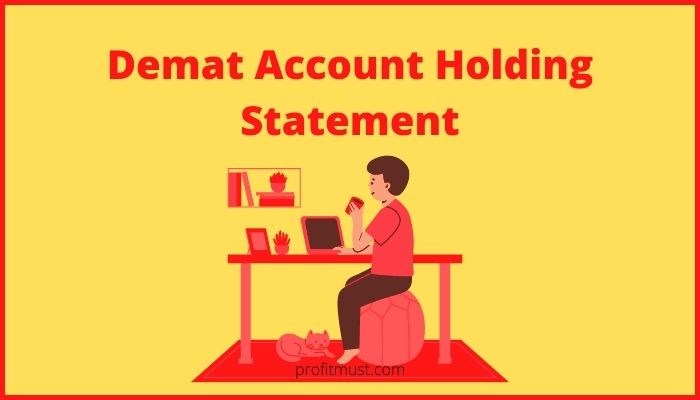Sometimes you might feel that buying and keeping stocks are good or bad? But where can the answer to this question be found? The answer is in your Demat account holding statement. Your holdings are the stocks you purchase with your Demat account with the purpose of long term and not selling them the same day.
Let’s discuss how to download the Demat Account holding statement & analyze it properly.
Table of Contents
Demat Account Holding Statement
A Demat account holding statement provides information on all of the stocks you own in your demat account similar to a bank statement. It gives you idea about in which direction your stocks are heading and it is good to hold them or you need to change your strategy.
How does it work?
You’ll need to register a demat account with a depository participant, or DP, to be able to buy and sell stocks online. A central depository – either CSDL or NSDL – registers DPs and keeps track of all demat transactions.
DPs also serve as brokers, acting as a middleman between the customer and the stock exchange. So, what occurs when you put a purchase order?
Although it appears to be as simple as pressing the buy button, the procedure is actually a lengthy one that takes place over several days and involves multiple steps.
Steps
- The stocks are first moved to the DP’s pool account, then transferred to the client’s account. This process normally takes T+2 business days to complete, where T is the day the transaction was started.
- Funds must be cleared from your demat account’s connected bank account, which means you must have enough money in your bank account to cover the transaction.
- Eventually, your stocks are sent to your demat account. When you retain shares in your account for longer than a day, they become holdings. If you sell them on the same day, though, they are shown as positions.
How to check stocks are credited in your demat account?
This is where the Demat holding statement comes into picture. The demat account holding statement is credible proof that you have acquired ownership of shares.
While this may seem simple, there are many instances where DPs store the stocks in their personal pool account rather than transferring them to the client. As a result, it’s a good idea to keep an eye on your demat holding statement on a regular basis.
A demat account holding statement is a thorough record of all the stocks you own, including the dates you bought them, their current value, and other pertinent information.
Demat holding statements are useful for tax purposes in addition to providing a clear view of your investments.
How to Download Demat Account Holding Statement?
You can check your statement of demat holdings in one of two methods:
-
Depository Website
In India, there are two major central depositories: CSDL and NSDL. Considering which national depository your demat account is established with, you can get your demat account statement straight from the CSDL or NSDL websites.
The NSDL normally assigns a 14-digit number to demat accounts, but the CSDL assigns a 16-digit number. To check your demat account holding statement, just go to the portal of the appropriate national depository and input your demat number.

-
Stockbroker
When you open an online demat account, your brokerage will give you a trading interface via which you can buy and sell securities online. This trading interface also allows you to examine your demat account holding statement.
For example, in the case of Zerodha, you must first log in with your login ID and password to the kite trading website. Then, from the dashboard that appears, select “console” then “Portfolio” and then on “holdings” .
This will bring up your holding statement for your demat account, which you can then browse or download as needed. Regardless of whose DP your trading account is with, you can follow a similar method.

Analyzing Demat Account Holding Statement
Your Demat Account Holding Statement contains a list of all the shares you own, the dates they were purchased, and their current value. It’s critical to keep a close eye on your demat account holding statement to ensure that the shares you bought have been moved to your demat account.
You can evaluate it in such a way that your stockbroker is not mismanaging your assets. It also aids in the decision-making process for future investments.
You can learn a lot of things, such as if your previous technique worked or not. Is there a need for a strategy adjustment, or are things operating according to the goals you intend to achieve with these investments in the future?
Conclusion
Your Demat account holding statement is conclusive proof of your stock ownership. It’s also beneficial in terms of taxes.
This is all from our side regarding the Demat account holding statement. Let us know your views in the comment section.

Other Interesting blogs related to Demat account holding statement:
Difference Between Demat and Trading Account
Frequently Asked Questions About Holding Statement for Demat Account
How can I get demat holdings statement?
Based on your broker's membership, you can get your Demat account statement straight from any of the depositories. To get your Demat account statement, go to their website and enter your Demat account number.
What is demat account Holding statement?
A demat account holding statement is a thorough record of all the stocks you own, including the dates you bought them, their current value, and other pertinent information. Demat holding statements are important for tax purposes as well as giving you a complete image of your investments.
How do I download a holding statement from CDSL?
Just Log-on to CDSL's website www.cdslindia.com. Click on Login to – CAS link available under 'Quick Links' on the homepage. Enter your pan card & demat account number. You will get your holding statement.
How can I download holding statement from NSDL?
The CAS can be sent to an investor's registered e-mail address in an electronic version known as the E-CAS. To access your most recent NSDL statement, go to nsdlcas.nsdl.com and click on the Track Your CAS page.
What holding means?
Holdings are the assets in a person's or a company's investment portfolio, including a mutual fund or a pension fund. Stocks, bonds, mutual funds, options, futures, and exchange traded funds are all examples of financial instruments that can be included in a portfolio (ETFs).

